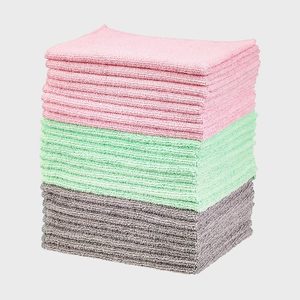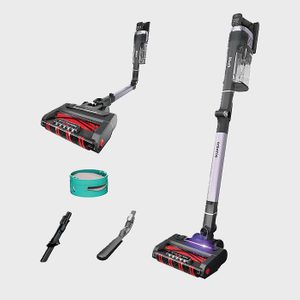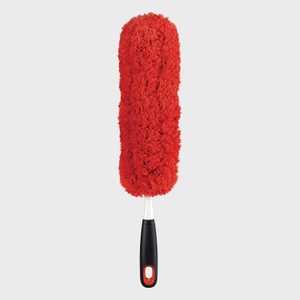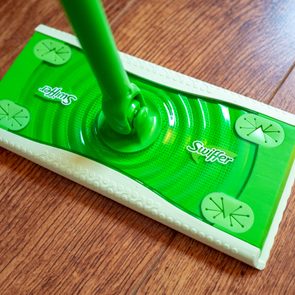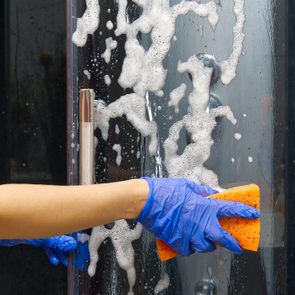How to Get Rid of Dust in Your Home—Easily and Effectively
Updated: Apr. 08, 2024
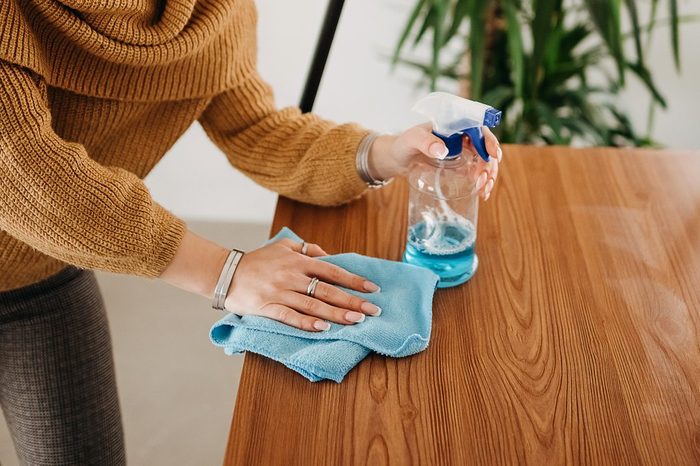
Most people just move dust around instead of actually eliminating it. Here’s how to dust the right way so you don’t make this common cleaning mistake.
Our editors and experts handpick every product we feature. We may earn a commission from your purchases.
Dusting can feel like you’re fighting a losing battle. And in some ways, you are—just like a horror-movie villain, dust keeps coming back. But you can get a handle on this relentless chore if you learn how to get rid of dust the right way and incorporate it into your regular cleaning schedule.
“Keeping up with dust is an ongoing task,” says Rachel Head, owner of Helping Hands Cleaning Service. “Most people do not dust often enough, and when they do, they overlook important spots.”
This is an unfortunate fact, whether you’re cleaning your bathroom, bedroom or kitchen … but we’re about to change all that. The key is not just to learn how to dust and where to dust but also which tools to use. This is just as important as having the correct supplies to clean hardwood floors and windows, and probably more so, because if you don’t dust correctly, you’re just moving around the dust instead of actually getting rid of it. Oh, and did we mention the dust mites? Yeah, those are in the mix too, and you’ll definitely want to evict them.
Ahead, learn the simple steps for how to clean and keep your home as dust-free as possible—including timesaving tips, tricks for hard-to-reach spots, and mistakes that make your space dustier than you realize. Your home will never be the same again, and that’s a good thing!
Get Reader’s Digest’s Read Up newsletter for more cleaning, travel, tech, humor and fun facts all week long.
Where does dust come from?
There isn’t just one place that dust comes from, which makes sense, because it truly seems to be everywhere. It occurs naturally in our homes, we track it inside and it floats in through open windows and doors. So, what is dust, exactly? It is a collection of small particles—like skin cells, human hair, pet fur and carpet fibers—as well as dander, pollen and bacteria. Gross, we know. And even worse, we breathe it in and ingest it, and also lie down in it.
If you’re wondering if this can cause health problems, the answer is a resounding yes. A recent investigation by Yale School of Public Health showed that dust can also contain metals, pesticides and chemicals, all recognized to impact our health adversely. Plus, even without all that, dust can exacerbate breathing issues for those affected by asthma, allergies and other respiratory conditions. But there is some good news here, according to the study’s authors: There are steps you can take to avoid having those potentially hazardous compounds in your home, and that includes frequent dusting.
How often should you dust?
We’re not going to lie—you need to dust pretty often. But think of it this way: Light, frequent dusting is a lot easier than putting it off and then having layers upon layers to dust. That said, if you or someone in your home has a sensitivity to dust, more frequent dusting is advised. As a general rule, though, here’s the best cleaning schedule to keep dust at bay.
- Daily: Swipe it if you see it, and wipe high-traffic spots in common areas, like the coffee table and furniture near open windows and doors.
- Weekly: Touch up the biggest and easiest-to-reach dust magnets. This includes hard furniture, decorative items like picture frames, commonly used electronics, plant leaves (real and faux) and lamp shades.
- Monthly: It’s time to bend and reach. Get baseboards down low, and lighting fixtures, ceiling fans, the top of the refrigerator, door frames and windowsills up high. It’s also time to deal with fabrics, drapes, mattresses and soft furniture. And don’t forget to clean the vacuum’s canister and filter according to the manufacturer’s instructions while you’re at it.
- Yearly: A yearly deep-clean includes moving heavy furniture to reach under and behind it, but also the underside of the piece as well, and addressing other out-of-the-way spots. Plus, you should dust walls and ceilings annually—yes, you’re supposed to be dusting those too!
How to dust
The first thing you need to know about how to get rid of dust effectively? Skip the duster, says Head. Instead, reach for a microfiber cloth, which has positively charged fibers to attract negatively charged particles, like dust, instead of just spreading it around. Dusting like a pro also means avoiding common mistakes, like dusting around items. “Like they always say, the sun shows everything!” says Head. Translation: You will continue to see patches of dust unless you remove everything to dust the entire surface.
Before we get into the specifics for each spot, here’s what you need to know for any dusting project:
- Gather your supplies. Save time by having what you need before you begin.
- Prep the area. Close windows and doors, and turn off fans. Also unplug items from an outlet before dusting them.
- Clear the surface. Remove small items, and dust them as you go.
- Follow the prescribed method for the surface or material. Give it a good wipe according to the directions below.
- Keep it clean. Swap out dirty tools for clean ones to prevent redistributing dust.
- Finish with the floor. After dusting, quickly vacuum to suck up any dust that floated to the ground.
- Clean the cleaning tools. Remember, dusty tools contribute to dust in your home. Get them clean now—and ready for the next dusting.
How to dust furniture
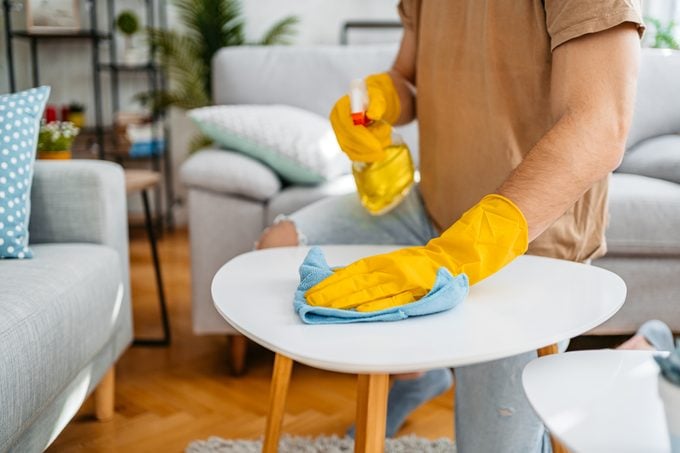
Supplies:
- Microfiber cleaning cloth
- Multi-surface dusting spray
- Glass-cleaning spray
- Vacuum with HEPA filtration
- Cotton swab (optional)
Directions:
- Clear the surface by moving things off the furniture, dusting each of them with a microfiber cloth as you go.
- Fold the cloth in half, and spritz the cloth (not the furniture) with multi-surface dusting or glass-cleaning spray, depending on the surface.
- Start at the top of the furniture, working your way down and wiping from side to side to remove the dust.
- Stop after five to six passes, flip the cloth to a clean side, and spritz again before continuing.
- Pay extra attention to intricate areas like carvings. The cloth should reach these areas, but if not, slide a cotton swab around the area to remove dust that’s settled into these deeper grooves.
- Use the hose attachment on the vacuum to get the underside of the furniture. Then pass the vacuum around the furniture to suck up any dust that drifted down. This is one of the places you’re not vacuuming—but should be.
Pro tip: Using too much dusting spray can cause a sticky buildup that actually attracts dust. Avoid over-spraying by spritzing the cloth, not the furniture. This also ensures that you don’t accidentally get the spray on fabric or any surrounding items.
How to dust fabric couches and chairs
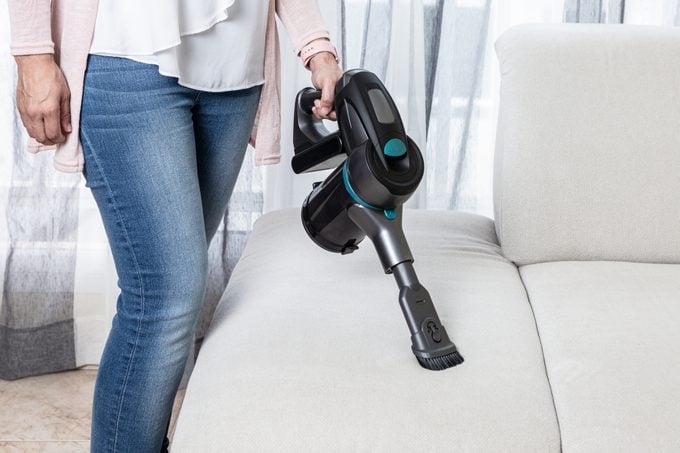
Supplies:
- Vacuum with HEPA filtration
- FurDozer squeegee (for pet owners)
Directions:
- Take off removable pillows and seat cushions, and place them to the side of your work area.
- Starting at the top of the couch or chair, use the vacuum’s brush attachment to suction in downward strokes.
- Slip the brush into crevices, like under the arm rests, along the backrest and between any attached pillows.
- Before returning pillows and seat cushions, pass the brush attachment over them.
- Slide the vacuum’s flexible wand (with the suction facing up) underneath the couch to dust the underside.
- Flip the wand over to dust the floor beneath the furniture.
- Vacuum the floor around the couch or chair, including where you placed the dusty pillows and seat cushions.
Pro tip: Pet owners should rely on the squeegee between couch cleanings; use short, firm strokes to easily remove pet hair embedded in fabric. And don’t miss these tips for how to clean all types of couches more thoroughly.
How to dust collectibles
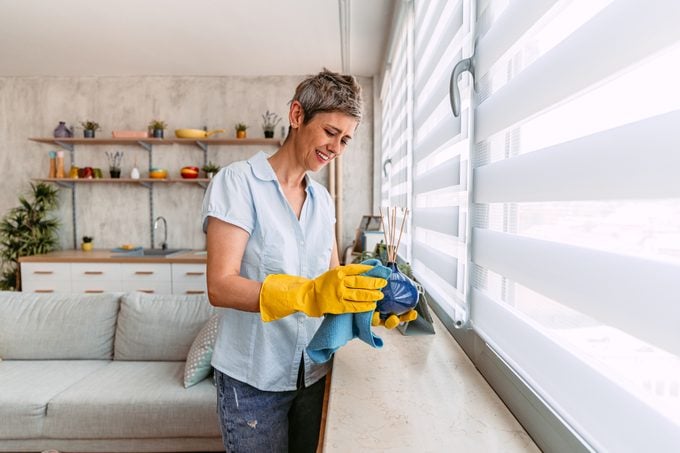
Supplies:
Directions:
- Dust collectibles one at a time. Remove moveable objects so you can get to the bottoms and also not brush dust onto the shelf.
- Fold the cloth, and gently pass it over the object. Avoid water or sprays unless you know they’re safe for the item.
- After every few passes, re-fold the cloth so you can dust with a fresh side.
- Swap out the cloth when all the sides have been used.
- Use the electrostatic duster brush to get any crevices the cloth will not reach.
- Repeat this process on each piece.
- Before returning items to their usual spots, wipe the display area.
Pro tip: Dust collectibles weekly, if possible, to prevent heavy buildup. You can also keep collectibles dust-free by displaying them in an easy-to-dust shadowbox or under a glass cloche.
How to dust blinds and drapes
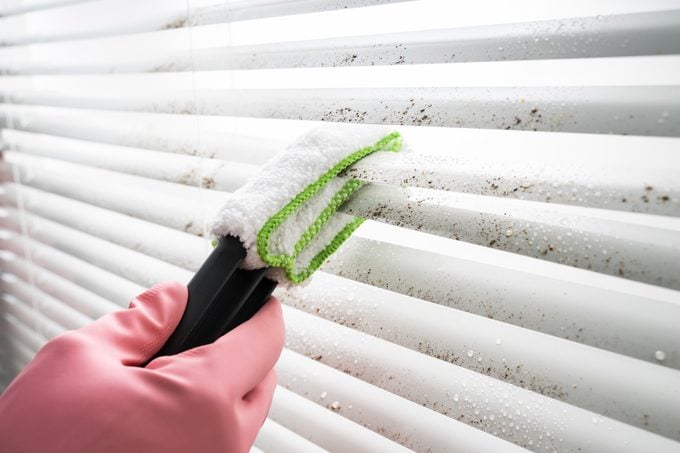
Supplies:
Directions:
- Gently sweep the drapes with the upholstery brush in a downward motion, forcing the dust off the fabric and to the floor.
- Slide the drapes to the side to access the blinds.
- Slip the three prongs of the microfiber duster between the top three slats on the left-hand side.
- Sweep the duster to the right and back again.
- Reposition the duster three slats down, and repeat until completely dusted. Here’s what to do if your blinds require a deeper clean.
- Once finished, vacuum the floor around the window to collect the fallen dust.
Pro tip: Put down the paper towels. “If you pick the right dusting tool, like the microfiber blind duster, it won’t leave lint behind,” says Head. “Plus, it traps the dust, keeping it away from the drapes.”
How to dust ceilings and walls
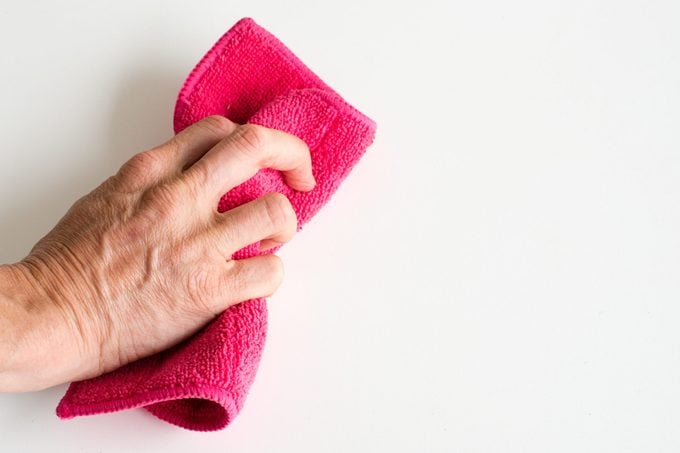
Supplies:
Directions:
- Remove picture frames, clocks and other wall decor.
- Use the dry cloth to wipe them, and then place them away from your work area.
- Use the cobweb duster (dry) to collect any cobwebs. Shake the duster outdoors if it becomes wrapped in webs.
- Use the dry lambswool duster to dust the walls, starting in the upper-left corner, then moving the duster across the wall—left to right and back again—until it is completely dusted. The wool can collect and hold a surprising amount of dust, so keep going.
- Repeat the same motion across the ceiling with the lambswool duster. If your ceiling is textured, follow these directions to clean a popcorn ceiling.
- Finish by washing the lambswool duster in the kitchen sink. Swish it around in warm water with a squirt of dish soap. Rinse thoroughly, then wrap it in a towel, gently wringing out excess water before allowing it to air-dry. When dusting isn’t enough, here’s how to give your walls and ceiling a deeper cleaning.
Pro tip: Wear a brimmed hat while working overhead to keep falling dust out of your face.
How to dust ceiling fans
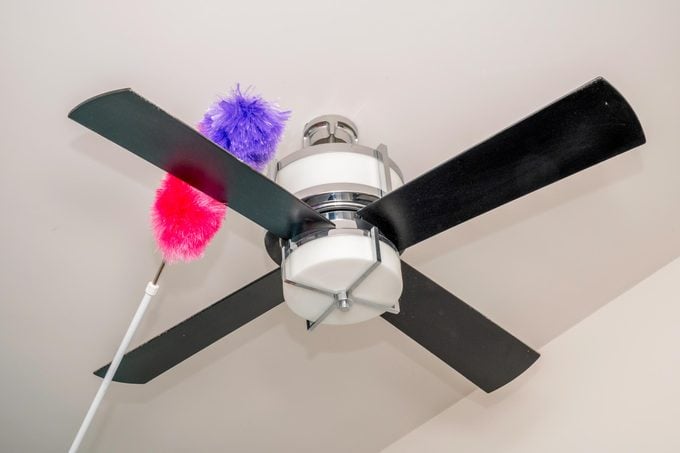
Supplies:
- Extendable reusable fan blade duster
- Multi-surface dusting spray (optional)
- Old bedsheet (optional)
Directions:
- Turn off the fan, and to be extra cautious, turn off the circuit breaker as well.
- Pass the dry duster over the pull chain to remove any dust.
- Slide the doughnut-shaped duster around one fan blade; the fluffy fibers will encircle the blade.
- Slide it along the surface, trapping the dust in the fibers as you move.
- Slide the duster off, and move to the next blade.
- Repeat on all blades.
- For extra-dirty blades, spritz dusting spray on the duster first.
Pro tip: To clean ceiling fans over the bed, cover bedding with an old sheet to protect it from loose dust.
How to dust baseboards, ledges and moldings
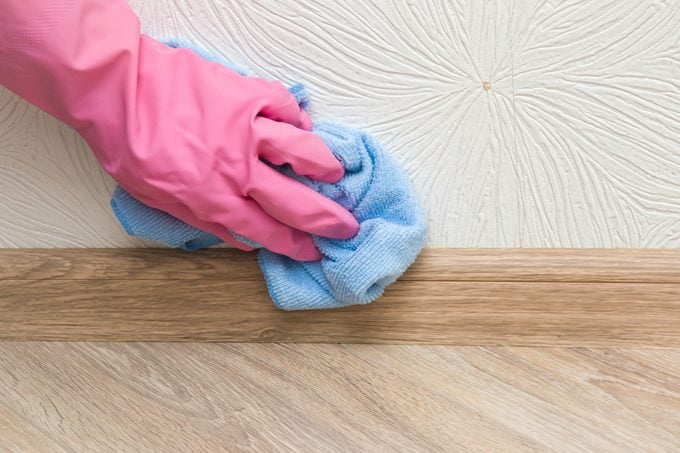
Supplies:
Directions:
- Whisk high ledges and door-frame moldings with a long-handled duster.
- Next, lightly wet a microfiber cloth. Tie it around the bristles of a broom, or secure it with a rubber band. You’ll use this for your baseboards.
- Starting in one corner of the room, glide the broom along the baseboard, working your way around the entire room.
- Rinse the microfiber cloth, wring well and replace the cloth between each room, or sooner if needed. If basic dusting isn’t enough, this is how to clean your baseboards more thoroughly.
- Always finish by vacuuming around the area where you worked to suck up fallen debris.
Pro tip: After dusting, run a new, dry dryer sheet over the baseboard. Use the ones you have on hand for laundry; any brand, scented or unscented, works. The antistatic agents create a static barrier, preventing dust from accumulating as fast.
How to dust TVs, computers and electronics
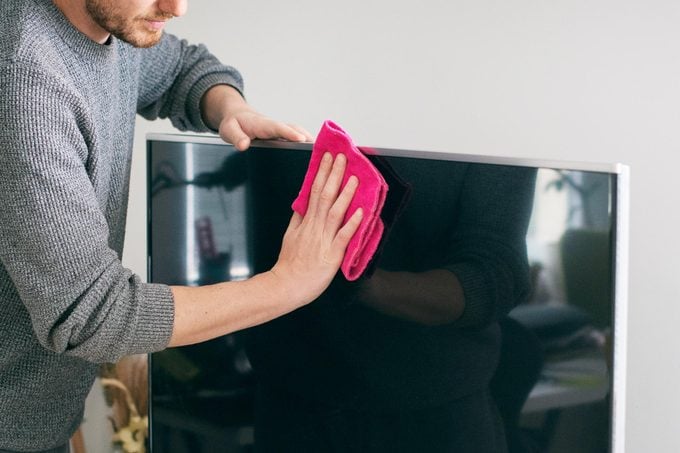
Supplies:
Directions:
- Unplug devices.
- Use the duster on everything but the screen.
- Finish by gently wiping the screen with a dry microfiber cloth. Consult the manufacturer instructions, because not following their recommendations can void the warranty. Here are more details on cleaning a TV and computer screen.
Pro tip: After unplugging your device, vacuum dust from the vents and around the power cord. These are often-overlooked spots.
How to dust vents and filters
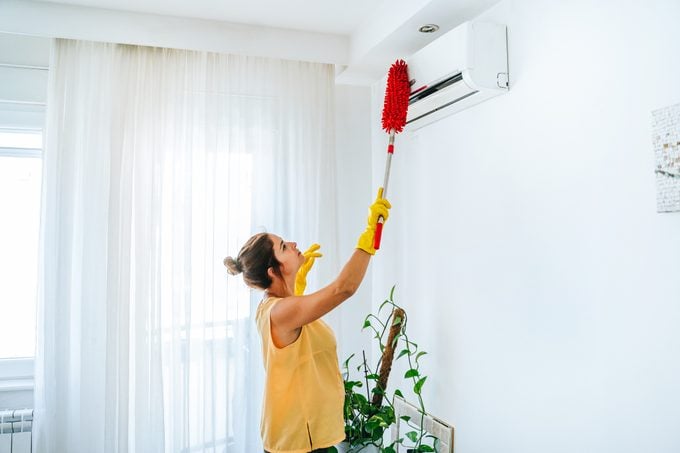
Supplies:
Directions:
- Before cleaning vents, turn off the heat or air conditioning.
- Use the vacuum’s brush attachment to clean the vents until there is no visible dust.
- Wipe any levers or knobs with a dry microfiber cloth.
Pro tip: Avoid using water or cleaning products on vents and filters. “Wetting dust turns it to sludge, which can make a mess of walls or ceilings,” warns Head.
Must-have dusting supplies
The 10 most overlooked spots you need to dust
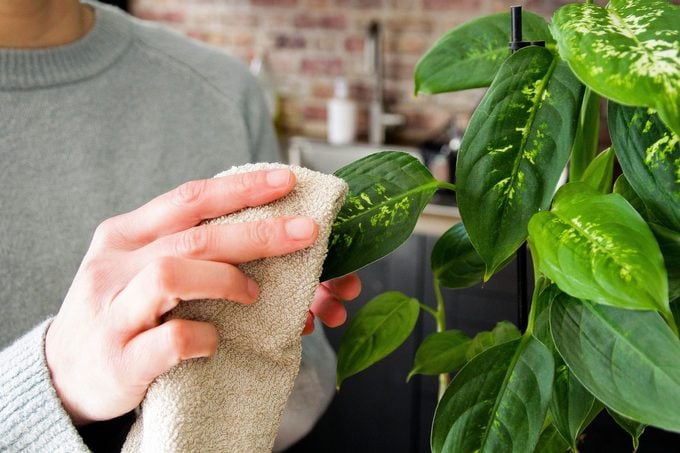
If you can’t remember the last time you dusted these items, then you’re long overdue!
- Candles
- Light bulbs
- Overhead light fixtures
- Picture frames and wall art
- Plant leaves (real and faux)
- The top of the refrigerator
- The undersides of furniture
- Throw pillows
- The tops of books
- Window and door-frame ledges
How can you prevent dust from getting into your home in the first place?
Of course, it’s always better to be on the offensive than the defensive—and that’s doubly true when it comes to how to get rid of dust. Whether you live on a busy road and you love to leave the windows open, or you keep the AC on in your roomy abode, there are a few things you can do to minimize the amount of dust that enters your home. And you won’t believe how simple they are!
Plug in an air purifier
Dust particles float through the air of your home until they find a place to land, like on carpeting or upholstery. An air purifier with HEPA filtration is the solution for how to get rid of dust in the air, since it traps dust particles before they have a chance to settle. This also means you’ll have less dusting to do in the long run. Set a reminder to clean or replace the filter on your air purifier, as directed.
Throw down a welcome mat
A big part of controlling dust is preventing it from ever getting in the house. Place a welcome mat at the various entry points to your home so you can wipe off your feet before coming inside. You can even install two mats, one outside and one directly in front of the door on the inside. That way, you have a double trap for that pesky dust. Just make sure to keep them clean by periodically shaking off the outside mat outdoors and vacuuming the indoor one.
Change your air filter
Wondering, Why is my house so dusty? Most of us are not changing the filters on our furnace and air conditioners (central or wall air units) often enough. Head recommends changing your air filter around the first of every month during the months the units are used; this will help with dust buildup tremendously. For easy reference, snap a photo of the instruction-book page detailing the filter size. Some are universal, while others are proprietary; either way, you need to buy the correct one.
Beat the rugs
Rug fibers are a breeding ground for dust. Frequent vacuuming gets most of the dust and dirt, but for a more thorough cleaning, take small and medium-size rugs outdoors once a month and give them a good shake. To take it a step further, hang the rug over a railing (pile side away from you), and beat it with a carpet beater to release even more of the deeply embedded dust.
Run a robot vacuum
Why do the dirty work yourself when you can have a trusty robot vacuum do it for you? Set the Shark AI Robot Vacuum & Mop loose on high-traffic areas of your home every day. Less dust on the floor means less work for you, and daily passes will prevent settled particles from going airborne and settling on surfaces or being tracked from room to room. Genius, right?
Wash your pillows regularly
Ready for a gross fact? Your pillows are probably dusty and crawling with dust mites. These microscopic arachnids love to feast on dead skin cells, and hundreds can live in just one gram of dust. You can even develop a dust-mite allergy; symptoms typically include a runny nose, itchy red eyes or a cough. To get rid of dust and dust mites, wash your pillows at least three times a year in hot water, and replace pillows every two years.
Declutter flat surfaces
Here’s a simple trick to eliminate dust in your house: Declutter! The less you display, the less there is to get dusty. Plus, clutter-free shelves and tables are easier to dust. Join the Reader’s Digest 5-Day Declutter Challenge to tidy up your whole space.
Sources:
- Rachael Head, owner of Helping Hands Cleaning Service
- Current Environmental Health Reports: “Prevalence and Implications of Per- and Polyfluoroalkyl Substances (PFAs) in Settled Dust”
- Yale School of Public Health: “Study identifies potentially harmful substances in household dust”

